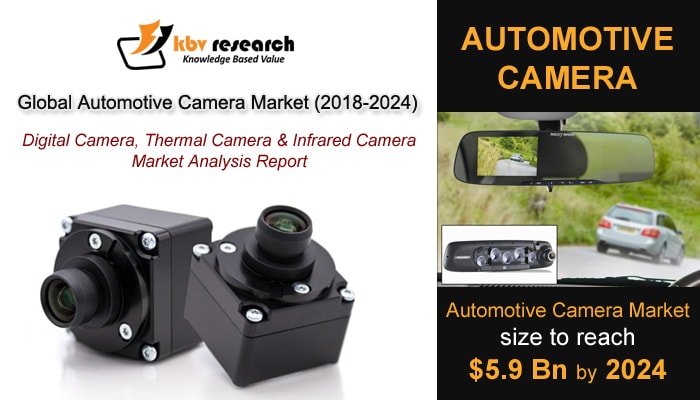
An Automotive Camera is designed to capture high-quality video to enhance visibility for providing better safety for the driver. Recent years have witnessed increasing concerns among consumers regarding security and safety. This has proven to be boosting factor in the development of automotive camera technology time and again. Consumers are installing advanced driver assistance systems and various legislations are mandating installation of cameras in vehicles. According to one of the leading market research company, KBV Research, these are some of the prominent factors that would offer extraordinary opportunities to the worldwide market of Automotive Camera and rise the industry up to $5.9 Billion with a growth rate of 29.8%.
Digital Camera
The technology for the digital camera is developed to be recognized as a requisite feature in every modern vehicle. Digital cameras are used in reversing aids, blind-spot backing systems, and obstacle-detection systems. Digital cameras are somewhat new products yet, their technology is evolving rapidly and effectively. Although digital cameras are mostly incorporated into mobile devices and vehicles, high-definition dedicated cameras have more adoption in professional arenas. Digital cameras are identified by wide-ranging sizes, prizes, and functions. Furthermore, specialized cameras like astrographs are used widely for military, medical, and scientific purposes. Digital cameras have made photography available to a larger mass of people. The latest editing technologies have transformed the way photographs are presented before the public.
Thermal Camera
Thermal cameras form a heat zone image which uses infrared radiation. It is similar to a common camera that forms images by using visible light. However, unlike a common camera, thermal cameras function in 14,000 nm wavelength. Thermal cameras integrated with video analytics, are considered the best way of detecting people in the outdoors. Developments, innovations, and price reductions have made them available for common security uses, which include prevention of theft and vandalism. When a thermal camera is monitoring the perimeter of a building, it mostly deals with low light scenarios, that it, nighttime hours. Advanced video analytics software has proven thermal cameras as cost-effective in a business protection scenario, mainly because, they reduce false alarm frequencies.
Automotive Camera in Blind Spot Detection
Blind spots are those areas around a vehicle where the eyes of a driver fail to reach. These areas can sometimes be caused by passengers, headrests, or window pillars. Mirrors can be used to eradicate the blind spots behind a vehicle, however, they tend to occupy a large area on both sides of the vehicle. A convex blind spot often does the job of a mirror in a better way. Nevertheless, the images displayed on a convex blind spot are distorted. This makes it difficult for a driver to figure out the actual distance. Having said that, automotive cameras in blind spot detection systems employ numerous sensors and cameras which provide nearly precise information about objects that might get missed out from the vision of a driver.
Lane Departure Warning System
Even a fleeting lapse in concentration while driving can drift a driver away from the lane. To assist a driver in sustaining concentration, lane departure warning function uses an automotive camera that can warn the driver of straying from the marked lane. Automotive cameras in such scenarios seldom help in avoiding accidents. When the camera detects that the vehicle is about to unintentionally move away from the lane, the driver gets cautioned by means of a visual, haptic, or an audible signal. The lane detection algorithm of an automotive camera tracks and classifies all common lane markups up to roughly 60 meters ahead, whether the road markings are continuous, white, dashed, yellow, red, or blue. These cameras serve greatly in avoiding accidents that can be caused by inadvertent drifting from the lane.
Trends and Future Perspective
The growing trend towards the use of automotive cameras in transportation is pushed by legislation as well as consumer demands for better safety and enhanced the driving experience. Self-driven cars are already demanding manufacturers to put automotive cameras for enhancing the features as well as improving the controlling functions in a vehicle. The ever-increasing demand and superior level supply of automotive cameras will significantly raise the market of this technology over the coming years.
Full Report: https://www.kbvresearch.com/automotive-camera-market/
Click Here For Free Insights: https://www.kbvresearch.com/news/automotive-camera-market-size/